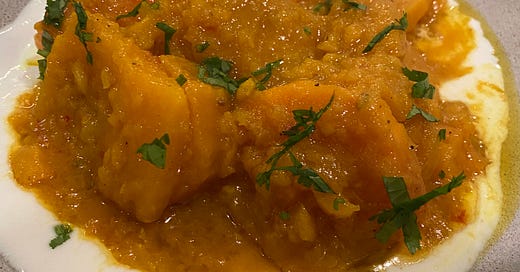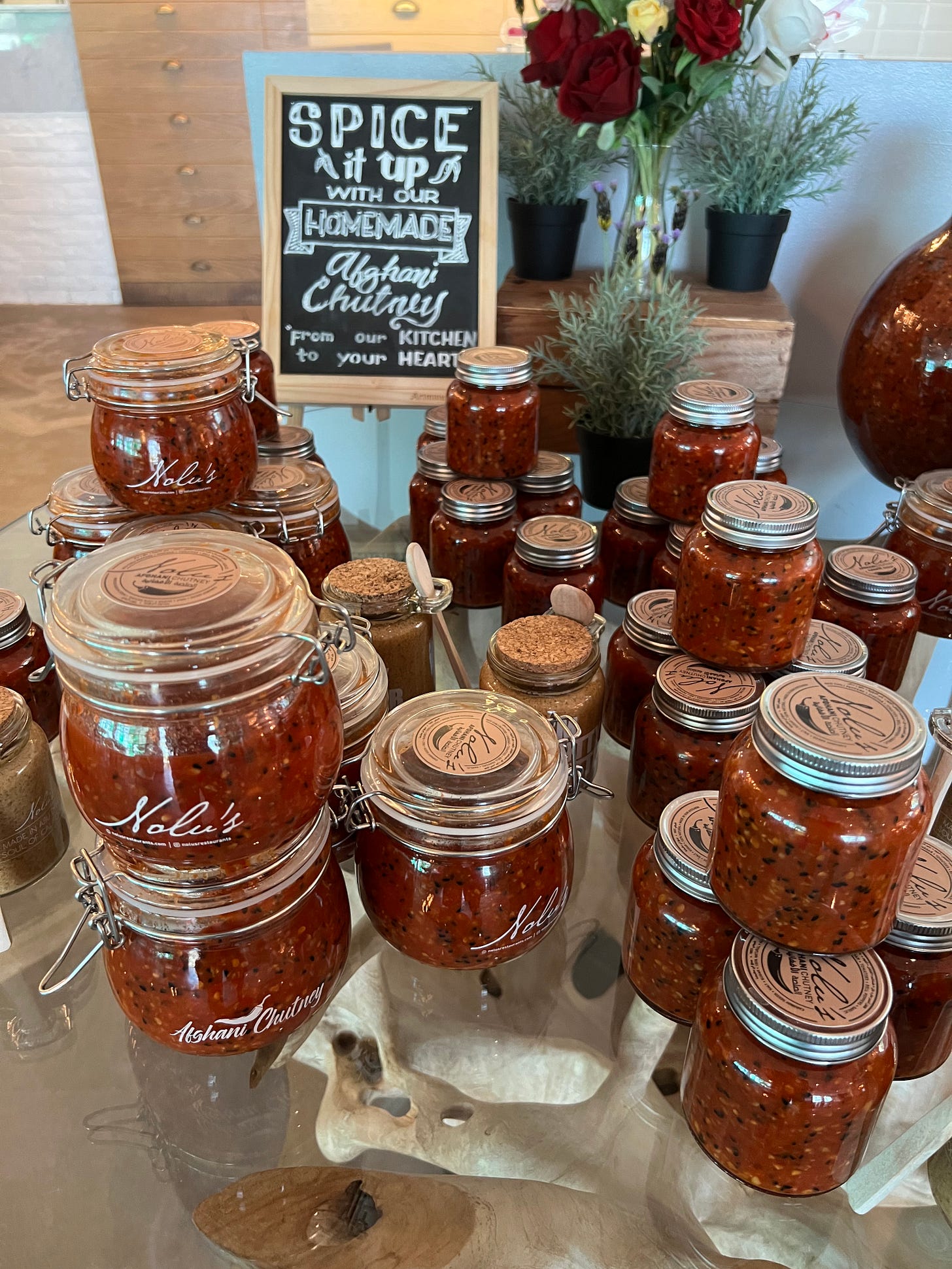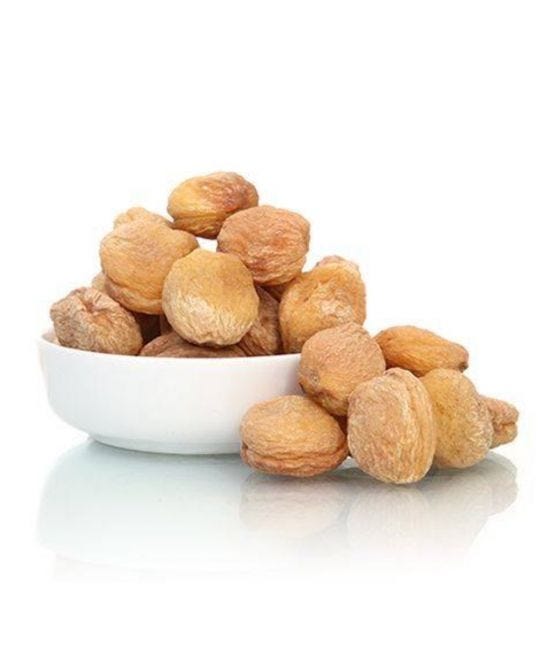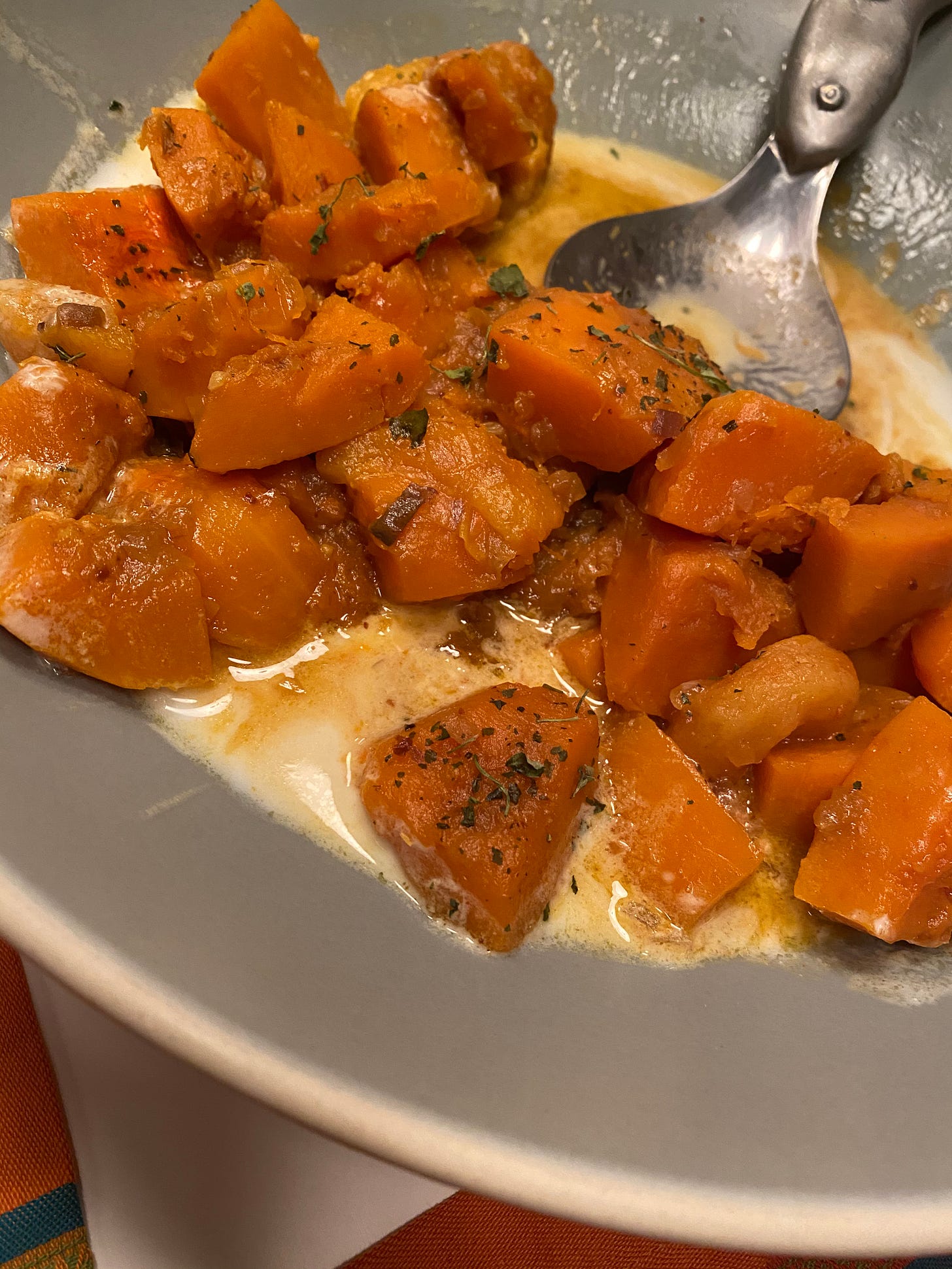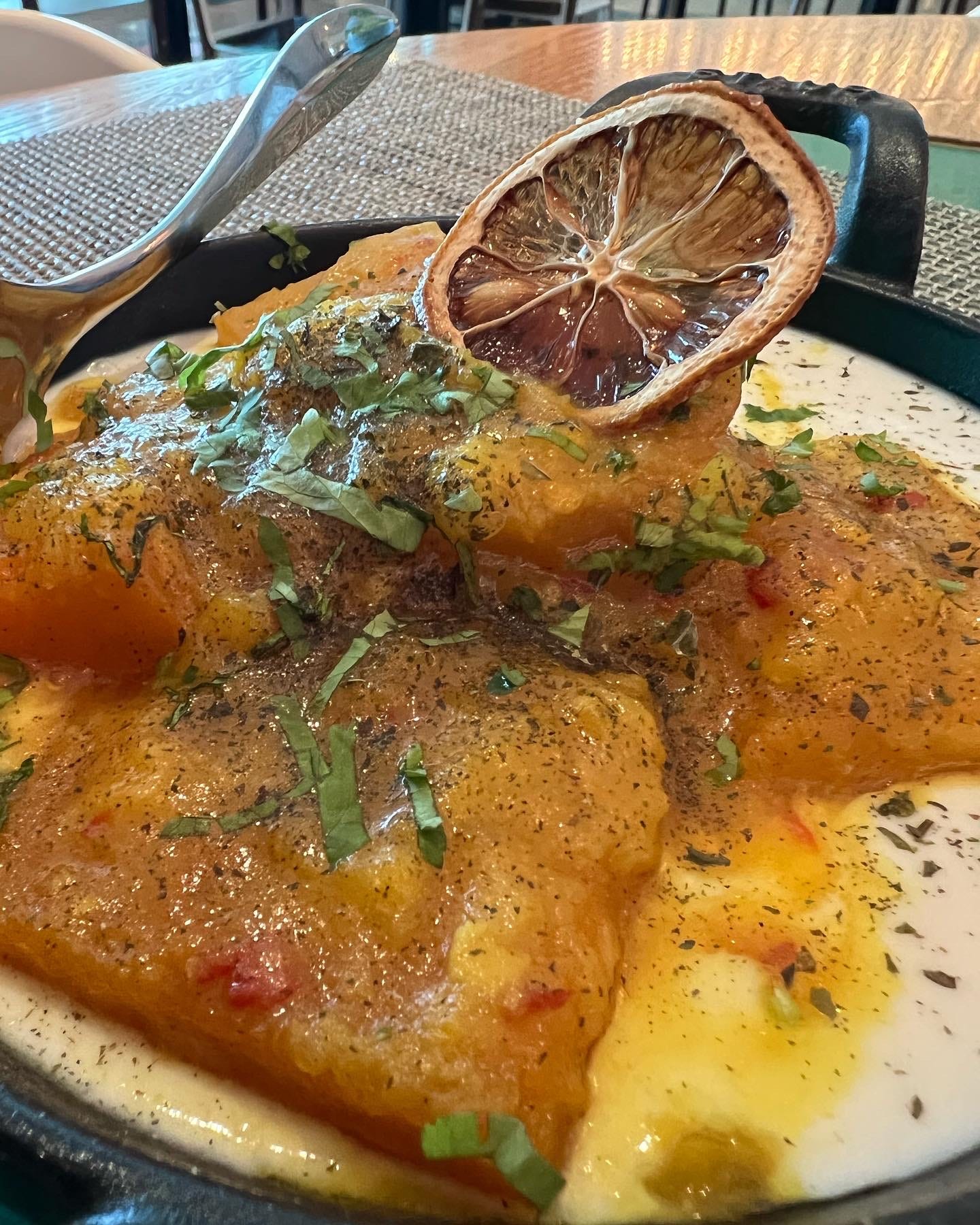Dispatch from the Middle East: Afghani Food in Abu Dhabi
Borani Kadoo or Saffron Braised Squash, A Chili Sauce to Remember, That Time I Stumped Kalustyan's
It’s 96°F (36°C) outside as I write Issue #42 from our friend’s apartment in Dubai. I’ve been overeating meze, flatbreads, grilled meats, regional Indian dishes, Basmati rice, and more for a week now. In a few days I’ll be back in Tel Aviv for work. Like so many during the pandemic, most of the traveling I’ve done over the last couple of years has been in my own kitchen, through the food I’ve cooked from around the world. It’s nice to be experiencing new flavors on the road again, but I’m most excited to bring them home and experiment with them myself. Thank you for continuing to join me on this culinary journey by signing up for this newsletter. Please share it, gift it, subscribe, and help spread the word. —Mitchell
The last big trip I took before the COVID-19 lockdown was to the United Arab Emirates in December 2019 for an illuminating conference called “Cooking the Nation” at New York University’s Abu Dhabi campus. Organized by cookbook author Hanan Sayed Worrell and cultural anthropologist Jonathan Shannon, the conference explored themes of cultural identity, culinary diplomacy, and the food of the Middle East. Upon arrival, my dear friends Marcus and Judi, who live in Dubai and who are probably reading this right now, picked me up at the airport in Abu Dhabi and took me to dinner at a great Afghani restaurant called Nolu’s. The restaurant bills itself as a place where “laid back California cool meets the smoky flavors of Afghani cuisine, all with a modern twist.” I have no idea what that means, but I loved the food, which was bright, boldly flavored, and deeply satisfying. We ordered a vast array of dishes, as is our MO, but there were many more on the menu I wanted to try.
Coincidentally, one of the dinners organized for conference speakers was at Nolu’s. So, just a few days later, I was back at the restaurant in the Galleria, this time sitting next to Marjon Ajami, the owner and chef, sampling all the Afghani specialties on the menu. Ajami’s family emigrated from Kabul to San Francisco in the late 1970s, where her mother opened an Afghani restaurant. Marjon moved to Abu Dhabi in 2004. Finding the local restaurants soulless and generally lacking, she decided to take matters into her own hands, creating Nolu’s, the name of which is a contraction of her children’s names, and the menu of which blends her dual Afghan and California heritages. Of all the wonderful things we sampled, two I wanted to take back home with me: the fiery chili sauce that’s on the table when you arrive (known as surkh-e-murch) and that fortunately the restaurant sells (I bought two large jars), and the recipe for borani kadoo, a butternut squash dish flavored with saffron, dried mint, yogurt, and sour apricots. Marjon explained to me how it was made. It was among the recipes she had contributed to Hanan’s book, Table Tales, about the great cooks and hosts of Abu Dhabi. A few days later I had a PDF of the recipe in my inbox.
The only ingredient called for in the dish that I didn’t have on hand was dried sour apricots, so I headed out to Kalustyan’s, which is conveniently located just a few blocks from my home. Kalustyan’s is the go-to source in New York City for any ingredient required for any cuisine. Founded in 1944 by Kerope Kalustyan, an Armenian from Turkey, the shop has evolved and grown over the decades. In 1988, the store was bought by Aziz Osmani and Sayedul Alam, and today it occupies three contiguous storefronts on the block of Lexington Avenue between 28th and 29th Streets. According to a recent New York Times profile, they stock ingredients and products sourced from 85 countries. Turns out the only thing I’ve ever asked for in 30 years I’ve been shopping there that they didn’t have was Afgahni dried sour apricots. I showed them the recipe. They didn’t know what they were. I felt a small sense of pride at having stumped them.
Defeated, I made my borani kadoo the first few times with the dried Blenheim slab apricots that you can find in season at Trader Joe’s. They are a little more tart and flavorful than the ordinary dried apricots you see everywhere. One day, while shopping in other stores in the Indian neighborhood that surrounds Kalustyans, I spotted a bag of small, shriveled dried fruits that had a faint greenish-orange tinge but were simply labeled “apricots.” Aha! I believed I had found what I was looking for and ever since have used these apricots to make this dish.
About the only other change I have made to the recipe is to substitute some white miso for the bouillon cubes that are called for in the original. I’ve no doubt part of the deliciousness of the dish in the restaurant comes from the concentrated umami flavor of these cubes, but I try to avoid unnatural sources of MSG in my cooking and seek alternate ways to add umpfh. (I realize I’m bucking the trend among certain influential chefs and food writers, who are all about cooking with MSG these days, but call me old-fashioned.) The umami-rich miso does not add any flavor of its own, rather it emphasizes the flavor of the squash.
This week Nate and I are back in the UAE with our friends Judi and Marcus. Although we’ve spent most of our time in Dubai and Oman, we did a day trip yesterday to Abu Dhabi and I didn’t want to leave without a return to Nolu’s. I’m out of her chili sauce and I wanted to sample the borani kadoo again at the source. It was every bit as delicious as I remembered.
Here is the recipe. Serve it warm or room temperature with flatbread to mop up the sauce.
RECIPE: Borani Kadoo or Afghani Braised Squash with Sour Apricots, Saffron, Dried Mint, and Garlic Yogurt
(Serves 6 to 8 as a side dish)
3 ounces pitted dried sour apricots, halved, or 4 ounces other dried apricots
1 ½ cups plain, full-fat yogurt
1 clove garlic, grated to a paste on a Microplane
Salt, to taste
Generous pinch of saffron
3 tablespoons peanut, avocado or other neutral vegetable oil
1 medium yellow onion, chopped
3 tablespoons white miso
1 tablespoon granulated sugar, to taste
1 teaspoon Aleppo or other mild, flavorful red chili flakes
1 medium butternut squash, about 2 ½ pounds, peeled, seeded, and cut into 1 1/2-inch chunks
1 teaspoon ground cardamom
1 tablespoon dried mint
Bring a tea kettle of water to a boil. If using the small, dried sour apricots, place the halves in a small bowl. Cover with bowling water and let sit to rehydrate. If using more common dried apricots, which are more plump, you do not need to rehydrate them.
Combine the yogurt and garlic and season with salt. Chill. Bring to room temperature before assembling the dish. Grind the saffron in a mortar and add 2 tablespoons of boiling water to release the colour and fragrance. Set aside
Heat the oil in a Dutch oven or other wide pot with a tight-fitting lid over medium heat. Add the onion and cook, stirring frequently, until it begins to caramelize. Add the miso, along with 1/2 cup of hot water to make a sauce. Stir in the saffron and its liquid, the sugar, and the chili flakes. Bring to a simmer, and then lower the heat. Add the squash and toss to combine all the ingredients. Sprinkle in the cardamom and add the apricots along with their soaking liquid. (If not soaking your apricots, add an additional ½ cup or so of hot water.) Increase the heat to bring to a boil, lower the heat to a simmer, cover, and cook the squash for 15 minutes, stirring occasionally, until the flesh is just al dente and the liquid has evaporated; the rich sauce should cling to the squash. Do not overcook the squash. But if you need more liquid until it is done, add it in small increments. The squash should hold its shape in large chunks and not be mushy. Adjust the seasoning to taste to balance the sweet, salty, and spicy flavors.
To serve, spread the room-temperature garlic yogurt on a serving platter and arrange the squash and any sauce on top. Sprinkle with the dried mint.
